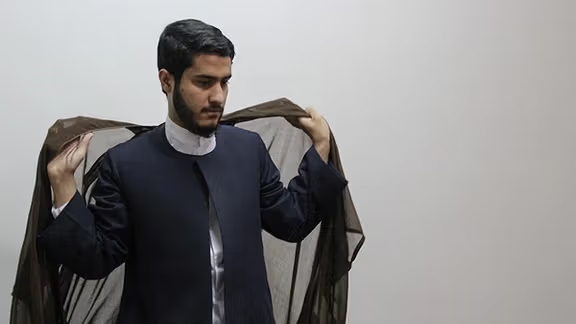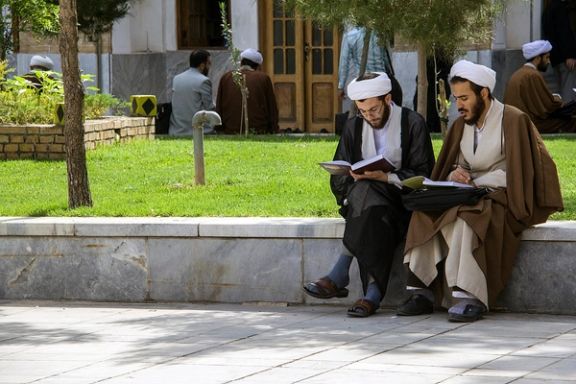The Lives of Iran’s Shiite Clerics – The Rules Of The Game - Avoid A Taxi

This article is the second in a series about Iran’s Shiite clerics, explaining how they study, get a clerical rank, get married and what they do for a living.

This article is the second in a series about Iran’s Shiite clerics, explaining how they study, get a clerical rank, get married and what they do for a living.
-------------------------------------------------------------------------------------------------------------------------
-Getting into the clerical robe and putting the turban on the head requires the completion of the introductory seminary courses and passing an easy exam which is mainly about ideology and ethics.
Clerical students usually put on a shirt without a collar and a pair of regular pants – no jeans. Putting on the robe and the turban is a turning point in the life of a young cleric. The turban or ammameh must be placed on the young cleric's head by a prominent clergyman or one highly respected by the students at the madrassah.
Once the young clergyman gets into the clerical outfit, he no longer is allowed to wear anything with a bright color. His shoes must be modest and devoid of any ornamentation. Most senior clerics frown at a young cleric with a wristwatch. They never wear it. However, in recent years, one might come across exceptions.
Generally, a typical cleric will walk and talk slower and dress more modestly once he gets his robe and turban. It is at this point that some clerics put on white turbans while others who are a seyyed or alleged descendants of the prophet will wear black turbans as a symbol of mourning for the martyred Imams particularly the third imam, Hussain

The clerical outfit usually consists of a turban and a robe, and two long and short jackets (labbadeh and qaba) put on under the robe, a delicate pair of white thin trousers and finally a pair of slippers (na'lain). If they have to wear shoes, shoelaces are frowned at and seen as a sign of immodesty.
Many clerics with hair loss, attribute it to the turban which is placed on their head all day and during part of the night. Most clerics traditionally keep their hairs short. After the 1979 revolution, many clerics, including Supreme Leader Ali Khamenei are not so keen to have regular haircuts. Some, again including Khamenei, allow a bit of hair to slip out of the turban on their forehead. These are believed by other clerics to be more modern, which is not necessarily a good trait.
Forcing a smile is good but a laughter is not supposed to be heard. Former President Hassan Rouhani was often criticized even by colleagues and fellow clerics for his laud laughter.
Although modern clerics usually go to see their relatives and sometimes have gatherings of family and close friends at their home, many older clerics rarely go for a visit to a friend or relative's house. The younger ones, mix with the rest of the family more often, although in most of their parties they shed their clerical outfit and get into something more secular.

Most clerics frown at traditional occasions for a family get together such as Nowruz (the New Year) or Yalda, (the longest night of the year). Nonetheless, younger clerics who have joined the ranks of akhunds during in the past two decades, celebrate the festive seasons like most other people.
However, many clerics have complained that they find it increasingly difficult to show up at shopping centers or the streets. Many Iranians, fed up with clerical rule, can hardly differentiate between those in the government and others who are teachers, or pastoral work or have small jobs here and there. Consequently, when they see them, they begin to voice their frustration and anger or at least try to tease a mullah.
Until some 40 years ago, most clerics and their families were familiar with concepts of andarouni (private interior) and birouni (less private exterior) in their homes which determined where the clerics could behave more comfortably, and where they had to be weary of prying. Nowadays, with smaller houses and flats these concepts have faded out and many occasions young and poor clerics find their dignity and privacy compromised.
If they are not rich enough to drive their own car or to be driven to work, taking a taxi is a nightmare for any cleric. Most taxi drivers prefer not to give a ride to an akhund. Or if they do, they most likely want to embarrass him in front of other passengers as taxis in Iran sometimes have up to five people on board.
During the fasting month of Ramadan and the mourning months of Muharram and Safar many young clerics travel to the provinces for "Islamic propagation." Most of the time, they are paid by the seminary or the government, while the pious local merchants also make sure that the visiting cleric is taken good care of and is paid good money by local businesses.
Youngsters in the provinces, however, fail to differentiate between these poor clerics who are dispatched to instill the party line and the Islamic Republic ideology among provincials. They constantly tease the mullahs for eating too much or having big pockets to collect easy money, or for wasting government resources. And the mullahs fail to understand that even villagers in Iran have access to satellite TV and foreign broadcasts which make them different from villagers in the past who took as fact whatever was uttered by a cleric.